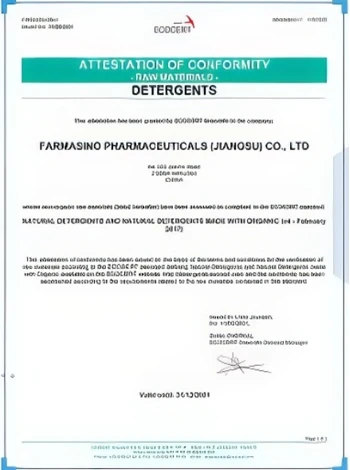



sodium chlorite vs sodium hypochlorite
Sodium Chlorite vs. Sodium Hypochlorite A Comparative Overview
Sodium chlorite (NaClO2) and sodium hypochlorite (NaClO) are two widely used chemical compounds with significant applications in various fields, including water treatment, sanitation, and disinfection. While they may seem similar, their properties, applications, and safety concerns differ considerably.
Chemical Properties and Reactions
Sodium hypochlorite is primarily known as the active ingredient in household bleach. It is a powerful oxidizing agent that releases chlorine when dissolved in water, making it effective for killing bacteria, viruses, and other pathogens. Sodium hypochlorite solutions typically range from 3% to 12% concentration for commercial use, and their efficacy is impacted by pH levels and the presence of organic matter.
On the other hand, sodium chlorite is less common in household products but is gaining attention for its unique properties. It is also an oxidizing agent but produces chlor dioxide (ClO2) when activated with acid. Chlorine dioxide is a highly effective disinfectant that can work at lower concentrations and is less affected by pH than hypochlorite. It is widely used in municipal water treatment, food processing, and deodorization applications.
Applications and Effectiveness
Both compounds are effective in disinfection, but their applications may vary due to their chemical behavior. Sodium hypochlorite is predominantly used for surface disinfection, water treatment, and as a bleaching agent in various industries. It is compatible with many surfaces and materials, making it a preferred choice in healthcare settings, schools, and households. However, its decomposing nature means that it loses efficacy over time, especially when exposed to light and heat.
sodium chlorite vs sodium hypochlorite

Sodium chlorite’s primary appeal lies in its ability to generate chlorine dioxide, which exhibits a broad spectrum of antimicrobial activity. It is particularly favored in water treatment processes due to its ability to remain effective in the presence of organic contaminants and biofilms. Additionally, chlorine dioxide is less likely to form chlorinated byproducts than sodium hypochlorite, making it a more environmentally friendly option.
Safety Considerations
Safety is a crucial aspect when dealing with these chemicals. Sodium hypochlorite, while effective, can be harmful if mishandled, causing skin irritation and respiratory issues if inhaled. It can also produce hazardous fumes when mixed with acids or ammonia.
Sodium chlorite, although generally considered less toxic, must be used with caution. It is essential to ensure proper activation when generating chlorine dioxide, as improper handling can lead to the release of gaseous byproducts that are hazardous.
Conclusion
In summary, sodium chlorite and sodium hypochlorite are both valuable chemical agents with distinct characteristics. While sodium hypochlorite remains a staple in domestic cleaning and disinfection, sodium chlorite’s ability to produce chlorine dioxide offers unique advantages in water treatment applications. Understanding their differences is key to selecting the right compound for specific needs while ensuring safety and efficacy in usage.
-
Why Sodium Persulfate Is Everywhere NowNewsJul.07,2025
-
Why Polyacrylamide Is in High DemandNewsJul.07,2025
-
Understanding Paint Chemicals and Their ApplicationsNewsJul.07,2025
-
Smart Use Of Mining ChemicalsNewsJul.07,2025
-
Practical Uses of Potassium MonopersulfateNewsJul.07,2025
-
Agrochemicals In Real FarmingNewsJul.07,2025
-
Sodium Chlorite Hot UsesNewsJul.01,2025










